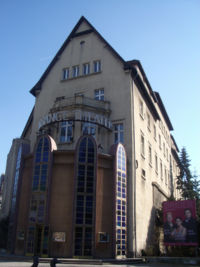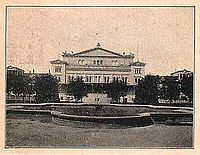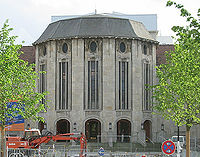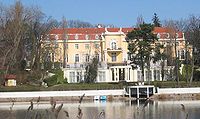
Oskar Kaufmann
Encyclopedia

Hungary
Hungary , officially the Republic of Hungary , is a landlocked country in Central Europe. It is situated in the Carpathian Basin and is bordered by Slovakia to the north, Ukraine and Romania to the east, Serbia and Croatia to the south, Slovenia to the southwest and Austria to the west. The...
-Jewish architect
Architect
An architect is a person trained in the planning, design and oversight of the construction of buildings. To practice architecture means to offer or render services in connection with the design and construction of a building, or group of buildings and the space within the site surrounding the...
. He was an expert of construction
Construction
In the fields of architecture and civil engineering, construction is a process that consists of the building or assembling of infrastructure. Far from being a single activity, large scale construction is a feat of human multitasking...
and design
Design
Design as a noun informally refers to a plan or convention for the construction of an object or a system while “to design” refers to making this plan...
and played an active part in Berlin
Berlin
Berlin is the capital city of Germany and is one of the 16 states of Germany. With a population of 3.45 million people, Berlin is Germany's largest city. It is the second most populous city proper and the seventh most populous urban area in the European Union...
since 1900.
Among his most well-known works are the Krolloper
Krolloper
The Kroll Opera House was an opera building in Berlin, Germany, located in the central Tiergarten district on the western edge of the Königsplatz square , facing the Reichstag building. It was built in 1844 as an entertainment venue for the restaurant owner Joseph Kroll...
in Berlin
Berlin
Berlin is the capital city of Germany and is one of the 16 states of Germany. With a population of 3.45 million people, Berlin is Germany's largest city. It is the second most populous city proper and the seventh most populous urban area in the European Union...
, the Hebbel Theater and the Renaissance Theater, both located in Berlin
Berlin
Berlin is the capital city of Germany and is one of the 16 states of Germany. With a population of 3.45 million people, Berlin is Germany's largest city. It is the second most populous city proper and the seventh most populous urban area in the European Union...
, Germany
Germany
Germany , officially the Federal Republic of Germany , is a federal parliamentary republic in Europe. The country consists of 16 states while the capital and largest city is Berlin. Germany covers an area of 357,021 km2 and has a largely temperate seasonal climate...
, the Neue Stadttheater in Vienna
Vienna
Vienna is the capital and largest city of the Republic of Austria and one of the nine states of Austria. Vienna is Austria's primary city, with a population of about 1.723 million , and is by far the largest city in Austria, as well as its cultural, economic, and political centre...
, and the Habima Theater
Habima Theater
The Habima Theatre , is the national theatre of Israel and one of the first Hebrew language theatres. It is located in Habima Square in the center of Tel Aviv.-History:...
in Tel Aviv
Tel Aviv
Tel Aviv , officially Tel Aviv-Yafo , is the second most populous city in Israel, with a population of 404,400 on a land area of . The city is located on the Israeli Mediterranean coastline in west-central Israel. It is the largest and most populous city in the metropolitan area of Gush Dan, with...
.
Youth and Education

Abitur
Abitur is a designation used in Germany, Finland and Estonia for final exams that pupils take at the end of their secondary education, usually after 12 or 13 years of schooling, see also for Germany Abitur after twelve years.The Zeugnis der Allgemeinen Hochschulreife, often referred to as...
, he began to study architecture at a university in Budapest
Budapest
Budapest is the capital of Hungary. As the largest city of Hungary, it is the country's principal political, cultural, commercial, industrial, and transportation centre. In 2011, Budapest had 1,733,685 inhabitants, down from its 1989 peak of 2,113,645 due to suburbanization. The Budapest Commuter...
. This created tension with Kaufmann's parents, who wished him to become pianist. The tension was so great that Kaufmann's parents refused to support him financially, so that he had to leave Hungary and continue his education in Germany, at the Großherzoglichen Technischen Hochschule (English: Technical High School of the Grand Duchy) located in the city of Karlsruhe
Karlsruhe
The City of Karlsruhe is a city in the southwest of Germany, in the state of Baden-Württemberg, located near the French-German border.Karlsruhe was founded in 1715 as Karlsruhe Palace, when Germany was a series of principalities and city states...
. Ironically, he supported himself by working as a pianist. This line of work placed him in contact with many people from the local opera scene. Among the people Kaufmann met in this social circle was the then-director of the Karlsruhe Hofoper (English: Municipal Opera of Karlsruhe), composer Felix Mottl
Felix Mottl
Felix Josef von Mottl was an Austrian conductor and composer. He was regarded as one of the most brilliant conductors of his day. He composed three operas, of which Agnes Bernauer was the most successful, as well as a string quartet and numerous songs and other music...
. Mottl appreciated Kaufmann's skills as a pianist, and Mottl and other musical contacts of Kaufmann's would prove to be great influencers of his later architectural work.
Among Kaufmann's teachers during his studies were Josef Durm, Otto Warth, Carl Schäfer, and Max Laeuger
Max Laeuger
Max Laeuger was a German architect.He was born and died in Lörrach.In 1928 he won a bronze medal in the art competitions of the Olympic Games for his "The Hamburg City Park".-External links:* *...
. Kaufmann graduated with his engineering diploma on December 14, 1899, with a grade of "good."
Also during his education in Karlsruhe, Kaufmann met his future bride, Emma Gönner, daughter of the mayor of the town of Baden-Baden
Baden-Baden
Baden-Baden is a spa town in Baden-Württemberg, Germany. It is located on the western foothills of the Black Forest, on the banks of the Oos River, in the region of Karlsruhe...
. They would marry in 1903, at which point Kaufmann converted
Religious conversion
Religious conversion is the adoption of a new religion that differs from the convert's previous religion. Changing from one denomination to another within the same religion is usually described as reaffiliation rather than conversion.People convert to a different religion for various reasons,...
to Christianity
Christianity
Christianity is a monotheistic religion based on the life and teachings of Jesus as presented in canonical gospels and other New Testament writings...
at his father-in-law's behest.
Early Berlin Years
In Berlin, Kaufmann got a job in the architectural firm of the well-known theater construction firm of Bernhard Sehring. Kaufmann was assigned to construct a new theater in the city of BielefeldBielefeld
Bielefeld is an independent city in the Ostwestfalen-Lippe Region in the north-east of North Rhine-Westphalia, Germany. With a population of 323,000, it is also the most populous city in the Regierungsbezirk Detmold...
. It was his first solo project, and was influenced by the work of another Karlsruhe architect, Hermann Billings, whom Kaufmann never actually met in person, although they lived in Karlsruhe at the same time. The influence of Alfred Messel
Alfred Messel
Alfred Messel was one of the most well-known German architects at the turning point to the 20th century, creating a new style for buildings which bridged the transition from historicism to modernism...
's works can also be seen in the building's design.
Self-Establishment


World War II
World War II, or the Second World War , was a global conflict lasting from 1939 to 1945, involving most of the world's nations—including all of the great powers—eventually forming two opposing military alliances: the Allies and the Axis...
. He was also contacted to coordinate the décor for a bedroom used the Wertheim
Wertheim (department store)
Wertheim was a large department store chain in pre-WWII Germany. It was founded by Georg Wertheim and operated four stores in Berlin, one in Rostock, one in Stralsund , and one in Breslau....
company. This job put Kaufmann into contact with theater entrepreneur and director
Theatre direction
A theatre director or stage director is a practitioner in the theatre field who oversees and orchestrates the mounting of a theatre production by unifying various endeavours and aspects of production...
Eugen Robert. Robert commissioned Kaufmann to help him in the construction of a new theater he was planning, as Robert had been deeply impressed with the theater Kaufmann had built in Bielefeld. In connection with this and other works Kaufmann constructed while in Sehring's office, Kaufmann established his own architecture firm in 1908, on Luitpold Street in the Schöneberg
Schöneberg
Schöneberg is a locality of Berlin, Germany. Until Berlin's 2001 administrative reform it was a separate borough including the locality of Friedenau. Together with the former borough of Tempelhof it is now part of the new borough of Tempelhof-Schöneberg....
section of Berlin. Later, this form would move to Ansbacher Street in the Charlottenburg section of the city. The theater that Robert commissioned Kaufmann to build, the Hebbel Theater, gained Kaufmann notoriety and widespread recognition for the first time. However, his perceived inexperience still counted against him, as he was not invited to make a bid on the renovation of the Bremerhaven City Theater. Only after one of the three architects invited to make a bid, Max Littmann
Max Littmann
Max Littmann was a German architect.Littmann was educated in the Gewerbeakademie Chemnitz and the Technische Hochschule Dresden...
, bowed out of the running, was Kaufmann invited to take his place.
Because of this perceived inexperience, it was therefore crucial when Kaufmann was selected, by a jury including such notable architects as Max Liebermann
Max Liebermann
Max Liebermann was a German-Jewish painter and printmaker best known for his etching and lithography.-Biography:...
and Otto March, to design a new building for the Charlottenburg
Charlottenburg
Charlottenburg is a locality of Berlin within the borough of Charlottenburg-Wilmersdorf, named after Queen consort Sophia Charlotte...
opera. However, this never came to fruition, due to various reasons. This notwithstanding, his work on the Bremerhaven and Hebbel theaters, as well as his selection by the Charlottenburg jury, all served to give Kaufmann a strong reputation as a theater architect. When the decision to exclude Kaufmann from a competition to redesign the Royal Opera House in Berlin on technical reasons, because he had not received German citizenship in his thirty years in Germany, was met with scorn and disagreement in the press and among architectural experts, his newfound reputation was only confirmed.
Collaboration with Eugen Stolzer
With his construction of the new City Theater of Bremerhaven, Kaufmann met the young Hungarian architect Eugen Stolzer. Sotler had stuided at the Technical University of MunichMunich
Munich The city's motto is "" . Before 2006, it was "Weltstadt mit Herz" . Its native name, , is derived from the Old High German Munichen, meaning "by the monks' place". The city's name derives from the monks of the Benedictine order who founded the city; hence the monk depicted on the city's coat...
from 1904 until 1908 and had won the Hungarian National Architecture award as well as a prize from the Paris
Paris
Paris is the capital and largest city in France, situated on the river Seine, in northern France, at the heart of the Île-de-France region...
ian École des Beaux-Arts. Stolzer had previously made blueprints for Kaufmann, who was so impressed with Stolzer that Kaufmann made him chief partner in his architectural firm in 1916. Stolzer and Kaufmann designed many of their buildings together, and had extremely similar styles.
World War I and the 20s

Conscription
Conscription is the compulsory enlistment of people in some sort of national service, most often military service. Conscription dates back to antiquity and continues in some countries to the present day under various names...
into the German military during World War I
World War I
World War I , which was predominantly called the World War or the Great War from its occurrence until 1939, and the First World War or World War I thereafter, was a major war centred in Europe that began on 28 July 1914 and lasted until 11 November 1918...
. He used this time to further his architectural firm. However, the war had a direct and negative impact on the amount of business Kaufmann's firm received. Also during this time, Kaufmann received a bid, never realized, from Max Reinhardt
Max Reinhardt
----Max Reinhardt was an Austrian theater and film director and actor.-Biography:...
, head of the influential Freier Volksbuhne (English: Free Folk Theater), to build a new ballet
Ballet
Ballet is a type of performance dance, that originated in the Italian Renaissance courts of the 15th century, and which was further developed in France and Russia as a concert dance form. The early portions preceded the invention of the proscenium stage and were presented in large chambers with...
theater. It is not clear, whether Reinhardt seriously wanted Kaufmann to build the new theater or not. From then on, Kaufmann decided to take private commissions.
Some of Kaufmann's first private commissions consisted of a series of villas built in and around Berlin. Many of these villas still stand today. Kaufmann, however, soon grew to dislike designing villas and other single-family dwellings, as they did not prove financially profitable enough for his firm. He returned to theater building, and constructed two notable theaters during this time, the Theater am Kurfürstendamm, and the Krolloper
Krolloper
The Kroll Opera House was an opera building in Berlin, Germany, located in the central Tiergarten district on the western edge of the Königsplatz square , facing the Reichstag building. It was built in 1844 as an entertainment venue for the restaurant owner Joseph Kroll...
. The latter took nine years to build, from 1920 to 1929.
Crisis and Emigration

Great Depression
The Great Depression was a severe worldwide economic depression in the decade preceding World War II. The timing of the Great Depression varied across nations, but in most countries it started in about 1929 and lasted until the late 1930s or early 1940s...
, although it did not affect Kaufmann's firm as strongly as many of his business contacts, caused a marked decline in the number of commissions his firm received. The Machtergreifung
Machtergreifung
Machtergreifung is a German word meaning "seizure of power". It is normally used specifically to refer to the Nazi takeover of power in the democratic Weimar Republic on 30 January 1933, the day Hitler was sworn in as Chancellor of Germany, turning it into the Nazi German dictatorship.-Term:The...
, or seizure of power by the Nazi Germany Party
National Socialist German Workers Party
The National Socialist German Workers' Party , commonly known in English as the Nazi Party, was a political party in Germany between 1920 and 1945. Its predecessor, the German Workers' Party , existed from 1919 to 1920...
in 1933, cause Kaufmann's partner, Eugen Stolzer, to flee to Palestine
Palestine
Palestine is a conventional name, among others, used to describe the geographic region between the Mediterranean Sea and the Jordan River, and various adjoining lands....
in May of that year. Kaufmann himself followed Stolzer to Palestine in September.
A Moscow
Moscow
Moscow is the capital, the most populous city, and the most populous federal subject of Russia. The city is a major political, economic, cultural, scientific, religious, financial, educational, and transportation centre of Russia and the continent...
-based theater group, the Habima group, wished to build a new theater in the city of Tel Aviv
Tel Aviv
Tel Aviv , officially Tel Aviv-Yafo , is the second most populous city in Israel, with a population of 404,400 on a land area of . The city is located on the Israeli Mediterranean coastline in west-central Israel. It is the largest and most populous city in the metropolitan area of Gush Dan, with...
. The project was first given to another German architect, Erich Mendelsohn
Erich Mendelsohn
Erich Mendelsohn was a Jewish German architect, known for his expressionist architecture in the 1920s, as well as for developing a dynamic functionalism in his projects for department stores and cinemas.-Early life:...
, but the bid was withdrawn after the Mendelsohn showed too little interest in the project. The new project then was offered to Kaufmann, who soon accepted, and moved his family to Palestine. In addition to this theater, he built a cinema for the city of Haifa
Haifa
Haifa is the largest city in northern Israel, and the third-largest city in the country, with a population of over 268,000. Another 300,000 people live in towns directly adjacent to the city including the cities of the Krayot, as well as, Tirat Carmel, Daliyat al-Karmel and Nesher...
, and a row of private apartments. However, in Palestine Kaufmann was unable to attain the same success and notoriety that he had attained in Berlin. On top of that, the economic situation in Palestine was quite poor, so much so that Kaufmann received no more commissions after 1937.
Return to Europe
Because of the Palestinian economic situation, Kaufmann was forced to return to Europe in 1939. His many contacts helped him on his journey, but the outbreak of World War IIWorld War II
World War II, or the Second World War , was a global conflict lasting from 1939 to 1945, involving most of the world's nations—including all of the great powers—eventually forming two opposing military alliances: the Allies and the Axis...
kept him from reaching his intended final destination, England
England
England is a country that is part of the United Kingdom. It shares land borders with Scotland to the north and Wales to the west; the Irish Sea is to the north west, the Celtic Sea to the south west, with the North Sea to the east and the English Channel to the south separating it from continental...
. The new, restrictive travel laws that were put into place around that time also made it impossible for Kaufmann to travel back to Palestine, as it was a British protectorate at the time. After September 1940, Kaufmann and his wife holed up in Bucharest
Bucharest
Bucharest is the capital municipality, cultural, industrial, and financial centre of Romania. It is the largest city in Romania, located in the southeast of the country, at , and lies on the banks of the Dâmbovița River....
, Romania
Romania
Romania is a country located at the crossroads of Central and Southeastern Europe, on the Lower Danube, within and outside the Carpathian arch, bordering on the Black Sea...
. However, the rising pressure put on the Romanian Jewish
Judaism
Judaism ) is the "religion, philosophy, and way of life" of the Jewish people...
community by the fascist
Fascism
Fascism is a radical authoritarian nationalist political ideology. Fascists seek to rejuvenate their nation based on commitment to the national community as an organic entity, in which individuals are bound together in national identity by suprapersonal connections of ancestry, culture, and blood...
government of Ion Antonescu
Ion Antonescu
Ion Victor Antonescu was a Romanian soldier, authoritarian politician and convicted war criminal. The Prime Minister and Conducător during most of World War II, he presided over two successive wartime dictatorships...
forced Kaufmann to move once again, to Hungary. The situation for Jewish war refugees in Hungary was better than in its surrounding countries, but still grim. Kaufmann's wife was not able to survive the harsh conditions and died in Hungary in 1942. Kaufmann avoided the mass deportation of Jews which took place in Hungary in 1944, but he was without income and found his financial situation worsening.
Final years
In 1947, the new Hungarian government, under President Zoltán TildyZoltán Tildy
Zoltán Tildy , was an influential leader of Hungary, who served as Prime Minister from 1945–1946 and President from 1946-1948 in the post-war period before the seizure of power by Soviet-backed communists....
, decreed that any artist over the age of 60, which included the then 74 year-old Kaufmann, would receive a state pension
Pension
In general, a pension is an arrangement to provide people with an income when they are no longer earning a regular income from employment. Pensions should not be confused with severance pay; the former is paid in regular installments, while the latter is paid in one lump sum.The terms retirement...
. Kaufmann was also able to continue his architectural work through government commissions. When Kaufmann died at the age of 79 in 1956, he had produced two more theaters. His final work, which was completed four years after his death, was the renovation of the Madách Theater in Budapest.

